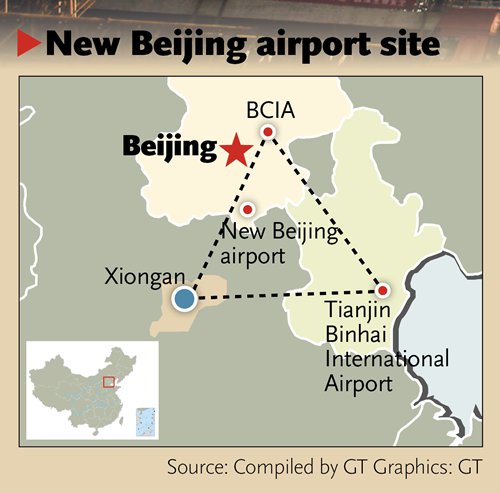
The nation's top three airlines eye Beijing's new airport as the ticket to international market breakthrough
China Eastern Airlines, one of China's top three airlines, was originally displeased about being moved to Beijing's soon-to-be-opened new international airport from Beijing Capital International Airport (BCIA), but now, it has had a change of thought.
On June 29, China Eastern said that it has started its base construction at the new airport.
With an investment of 13 billion yuan ($1.9 billion), China Eastern will build facilities including aircraft maintenance, catering, ground services, and cargo handling. The carrier said it will station 150 to 200 narrow-body and wide-body aircraft there and will connect routes to destinations including America, Europe, Australia and Japan.
China Eastern said its passenger flow could reach 30 million a year.
It is clear that it has changed its mind mainly due to the fact that the central government has decided to build the Xiongan New Area, an economic zone near the southern part of Beijing.
The new airport, located in Daxing district, 46 kilometers from Beijing's city center, is being built to ease off the pressure for the over-crowded BCIA, which is located in Beijing's northeastern suburbs. The distance between the two airports is about 67 kilometers.
The new airport started to take shape ever since the steel structures of the terminal buildings were completed on June 30 and is expected to begin operations in 2019.
Upon completion, the new airport, which will be only 55 kilometers away from Xiongan and about 85 kilometers from Tianjin Binhai International Airport, can also bring transportation convenience to residents nearby Beijing's southern part.
In capacity terms, the new airport has been designed to handle up to 72 million passengers and 2 million tons of cargo each year by 2025.
Benefits for national airlines
The new airport in Beijing is also anticipated to benefit many airlines which struggle to develop and prosper in BCIA by providing them with the opportunity to transfer their capacity to the southern part of the city.
In the future, China Eastern, along with China Southern Airlines, will be the main operators at Beijing's new airport as the two parties have been guaranteed to hold 40 percent shares, respectively, of the new airport's passenger capacity.
SkyTeam, the airline alliance of China Eastern and China Southern, has also quietly changed its attitude toward the possibilities of moving their operations to the new airport.
Perry Cantarutti, CEO of SkyTeam, said in an interview late last year with the Beijing-based China Times newspaper that SkyTeam will include two airports, the BCIA and the new airport, into their future core development strategies. Still, some airlines have not decided to move to the new airport yet.
But in June, Cantarutti said Beijing's new airport will increase daily flights for China Southern and China Eastern and that in the long term, the Xiongan New Area will bring opportunities for the airport and the airlines that decide to operate there.
However, the development of the new airport has broken the compromise among the "three giants": Air China, China Eastern and China Southern. These airlines dominate in their regional cities, with Air China occupying Beijing, China Eastern holding Shanghai, the financial center, and China Southern controlling Guangzhou, capital of South China's Guangdong Province.
So far, each airline has struggled to dominate in their rival's territory, leaving China Southern with slim chances of winning the demands of the European and American markets, a stark contrast to Air China and China Eastern.
It could be said that China Southern is taking a big risk in operating at the new airport, but the same could also be said for the Shanghai-dominating China Eastern.
The reality is, no matter how China Eastern, China Southern or SkyTeam decide to strategize, what they ultimately care most about is winning a slot in the European and American markets when the new airport opens in 2019.
Currently, Beijing-dominating Air China, the largest carrier at BCIA, has sneaked into the Shanghai market by establishing routes to Europe and America. Once the two rivals - China Eastern and China Southern - officially open their new routes from the new Beijing airport, Air China will inevitably feel challenged, which is the last thing it wants.
During a forum held in May, Ma Chongxian, deputy general manager of Air China Group, parent of Air China, said that the development of operations at BCIA and Beijing's new airport should be based on the pre-condition that if they could improve competitiveness in Beijing, the two should adopt different strategies in order to beef up China's competition in the global market.
It is clear that Air China has different expectations for Beijing's new international airport in comparison to China Eastern and China Southern.
The new airport in Beijing has therefore paved the way for future competition between the three giants.


















































